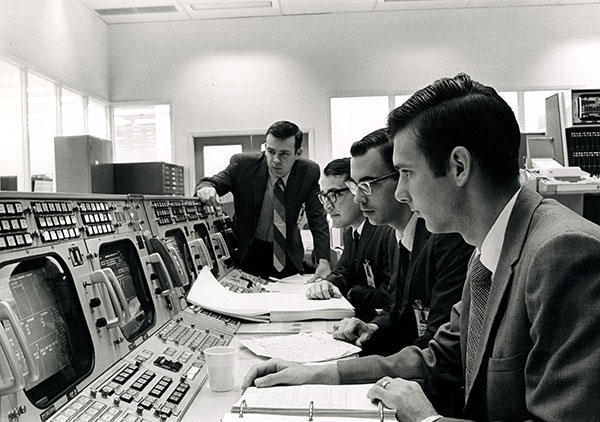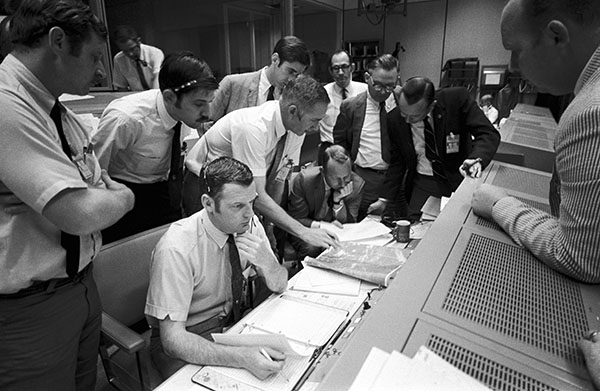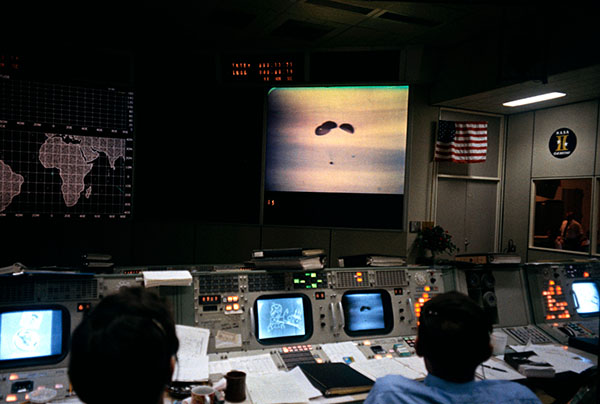Latest News
Bringing Apollo 13 Home
A personal memory of the work to save the lunar mission—from an IBMer who helped program its mission control systems By Albert McKeon Photographed at their consoles at NASA are are IBM...
A personal memory of the work to save the lunar mission—from an IBMer who helped program its mission control systems
By Albert McKeon

Photographed at their consoles at NASA are are IBM programmers Dave Proctor (standing),
Gordon Myers (seated, far left), John Yonkers (middle), Homer Ahr (foreground). (Photo: IBM)
When Apollo 13, the third manned mission to the moon, launched on April 11, 1970, it was barely front-page news.
While the entire world had been captivated by the Apollo 11 moon landing nine months earlier, by now, many people had become familiar with lunar expeditions—some might even say, bored with them.
That changed quickly late in the evening of Friday, April 13, when a short circuit trigged an explosion in one of the spacecraft’s oxygen tanks. The three astronauts on board heard and felt a loud bang, prompting Commander Jim Lovell’s now famous report, “Houston, we’ve had a problem.”
What followed was a gripping three-day struggle to bring Apollo home safely. Suddenly, the space program again had the world’s attention.
As part of the workforce that helped build NASA’s computer systems and guide each Apollo mission, IBMers had a front-row seat to that drama. And some of those IBMers played a bigger role, including a 23-year-old Homer Ahr, a programmer who had also been on duty for the Apollo 11 moon landing.
The evening of April 13, after working a long day at NASA’s Manned Spacecraft Center in Houston, Ahr had returned home. Watching the local news, he heard a reporter say that something unusual had happened, based on the activities of NASA employees. Ahr went to sleep—in preparation for being called back at any moment.
He slept no more than 15 minutes. A phone call from his manager, Dave Proctor, woke Ahr and provided him with details: A secondary oxygen tank on Apollo 13 had exploded, causing the primary tank to also fail. The Command Module was quickly losing its supply of electricity, breathable air and water. Now 200,000 miles away from Earth, the astronauts were abandoning the moon landing and hoping NASA could offer a plan on how to get home in a severely disabled spacecraft. Proctor told him to come back to work. Ahr and fellow IBM programmer Gordon Myers would need to help NASA reconfigure Apollo 13’s trajectory to Earth.
History shows that Apollo 13 was a “successful failure,” NASA’s view that despite the danger to the astronauts, lessons could be learned from the furious scramble to return them back safely. NASA’s controllers, assisted by Ahr, Myers and many others, had to devise, on the spot, new flight procedures and navigational actions.
IBMers were there because the company created and managed the computing and data processing system that calculated, in advance, every maneuver that an Apollo spacecraft needed to take on its way to the moon and back. Those IBM computers ran in the Real-Time Computer Complex (RTCC) in Houston, a couple of floors below the Mission Control room.

NASA flight controllers at Mission Control during the Apollo 13 mission (Photo: NASA)
With Apollo 13 damaged and the clock ticking, NASA had to perform an analysis to verify that a new flight maneuver could propel the Lunar Module, where the astronauts had taken shelter, back into a good trajectory for Earth. As it happened, Ahr and Myers had recently written a new program that calculated maneuvers for the Lunar Module—a contingency that had seemed very unlikely to ever be used. Now, it was critical to the safety of astronauts Lovell, Fred Haise and John Swigert.
Just as science and human ingenuity are today aiming to curb a public health crisis, knowledge and resourcefulness steered the crippled Apollo 13 spacecraft home, instructing future generations on how people and computers can reach new heights even when things go wrong.
Retired after a 37-year career with IBM, Ahr, now 73, recounted in an interview how his role in saving Apollo 13 relied on data, intuition and narrow focus.
As you worked through the night of April 13, were you nervous?
Ahr: It was kind of frightening that I was just 23 years old. Gordon Myers was four years older and our manager, Dave Proctor, was seven years older. But we understood the physics, astronomy and math, and we could write the software. For those of us who supported missions in real time, there was a fighter-pilot mentality. The greater the pressure, the greater your focus.
We ate, but not much. We drank a lot of coffee. I eventually took off my suit coat and loosened my tie.
Unsure about firing up the engines on the damaged part of the spacecraft, and with the astronauts contending with a limited amount of oxygen and power, NASA Flight Director Gene Kranz decided to use the descent engines on the lunar module to get the astronauts home. When you returned to the Manned Spacecraft Center that night, what were your marching orders?
We had to do a dispersion analysis, which is essentially a verification of the models that would determine the trajectories of the “slingshot” maneuver around the moon. The astronauts were on what is known as a “free return” to get back to Earth, but it was a slow path. Left on that trajectory, by the time they got back they would have run out of oxygen. We had to get them back a day earlier. Only the power of the Lunar Module’s descent propulsion system could do that.
The maneuver had to consider the mathematical and physical parameters of two different orbital bodies: the moon and Earth. You’re melding two conical sections and two orbital sets of data and then you have to iterate a maneuver. It would be like figuring out how to shoot a BB through an edge of a sheet of paper that’s 20 feet away and placed on the edge of a basketball. The corridor Apollo 13 had to hit to reach Earth was fairly small. Hit it too low, you burn up. Hit it too high, you skip out into space.
What did your and Gordon Myers’s work entail?
Using the descent engine as a backup engine was on a long list of contingency steps. NASA told us before the launch of 13 that if we had time to write the computations for firing the descent engine in this type of position, do it. We knew how to model for that, so we wrote the software.
What was unique on April 13th and 14th was that we had to figure out a maneuver around the moon to get them to Earth a day faster. They wanted us to do the maneuver that we had written for the software but that no one had attempted before or tested in a simulation. This software had never been run by anybody but us.
So, you were not only verifying the software you and Gordon had written, but you were also factoring the current position of Apollo 13?
Yes, not knowing what exactly had happened in the explosion presented a lot of factors that would make this maneuver risky. We had a lot of parameters to consider: engine thrust levels, guidance angles, navigation parameters. You had to model acceleration based on thrust levels and the descent engine had many. We varied all the things we could vary by 10 percent to be sure that when Apollo came around the moon, it would all be good. We had to specify trajectories for all of these maneuvers. The angles pointed Apollo in the right direction, but they had to continuously change to achieve what we needed to do.
Gordon and I captured everything from the primary computer onto tape, every bit of data the flight controllers saw. There was also a backup computer running in real time. We brought that tape to a third computer to do the analysis.
Were you able to watch the slingshot maneuver happen?
We ran the analysis for many hours. The more scenarios we tried, the more confident we got.
The dynamics console that Gordon and I worked on was in a support room located next to the RTCC on the first floor of a building at the Mission Control Center of the Manned Spacecraft Center. The flight director and his immediate flight controllers were in the Mission Operation Control Room (MOCR), the room shown in the movies, on the third floor. Mission Control could not fly a mission without the RTCC. Our consoles were staffed 24/7, like the MOCR, during a mission.
We hung around the dynamics console to watch the maneuver. We saw enough radar data to know what happened. I don’t know if I went home on the 14th. I was running on adrenaline. We went home eventually, and we were back at the console on the 17th when Apollo landed.

Watching Apollo 13's splashdown at Mission Control (Photo: NASA)
How did you feel when the astronauts splashed down?
When it was over, a buddy of mine said, “Phew, I’m glad that’s over with.” I thought, “I’m glad I didn’t screw that up.” I was happy to see them home. People often ask me what the experience was like.
In every line of code we wrote, it was all around the idea that astronauts could lose their lives. Apollo 13 was a life-or-death situation, but you had to focus on your job. You had to do the right thing. That’s the essence of the “right stuff."
Homer Ahr, Gordon Myers and Dave Proctor were included as members of the NASA Mission Operations Team that received, in 1970, the Presidential Medal of Freedom to recognize their efforts in getting the astronauts of Apollo 13 home safely. They represented the thousands of IBMers who supported the Apollo program.